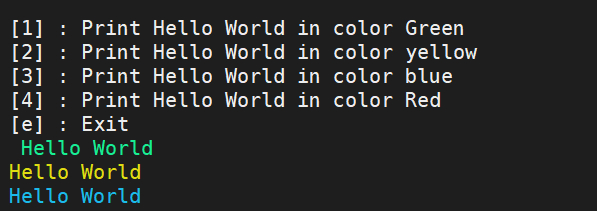In this tutorial, we will explain how to give user input in cronjob script.
How to give user input in cronjob script
There are two-ways to do this:
- Simply modify your script so it does not need user input.
- Feed the script its required input from a file, via “<”
Example for option 2:
I am having a simple script which will print “hello world” in different color as per the user input.
#!/bin/bash red=$'\e[1;31m' grn=$'\e[1;32m' yel=$'\e[1;33m' blu=$'\e[1;34m' end=$'\e[0m' printf "\n [1] : Print Hello World in Green color \n \ [2] : Print Hello World in yellow color \n \ [3] : Print Hello World in blue color \n \ [4] : Print Hello World in Red color \n \ [e] : Exit \n " #read user_input read -p "Enter choice: " ch for i in ${ch} do if [ "$i" == "1" ]; then printf "$grn Hello World $end \n" else if [ "$i" == "2" ]; then printf "$yel Hello World $end \n" else if [ "$i" == "3" ]; then printf "$blu Hello World $end \n" else if [ "$i" == "4" ]; then printf "$red Hello World $end \n" else if [ "$i" == "e" ]; then break fi fi fi fi fi done
To schedule this in crontab with user input, easy way to create a simple text file with your Input and this file will be given as stdin to the script.
$ cat input-file.txt 1 2 3
So I have created text file “input-file.txt”. This file is given as stdin to the cronjob script.
$ crontab -l 0 * * * * /usr/bin/sh -c "/home/centos/test-color.sh < input-file.txt"
Sample Output:
$ /usr/bin/sh -c "/home/centos/test-color.sh < input-file.txt" [1] : Print Hello World in color Green [2] : Print Hello World in color yellow [3] : Print Hello World in color blue [4] : Print Hello World in color Red [e] : Exit Hello World Hello World Hello World $ cat input-file.txt 1 2 3 $
Screenshot of sample output:
Another example for option 2:
If you need only confirmation (yes) in your script, then crontab can look like this:
0 * * * * /bin/sh -c “yes | /foo/bar/my_command”
0 * * * * /bin/sh -c “yes | /path-of-script/script”
This is the end of topic – How to give user input in cronjob script.
See Also:










